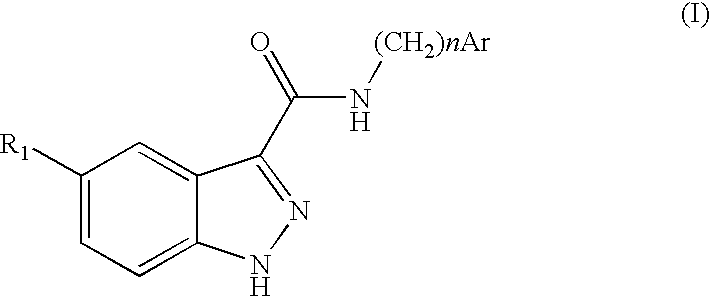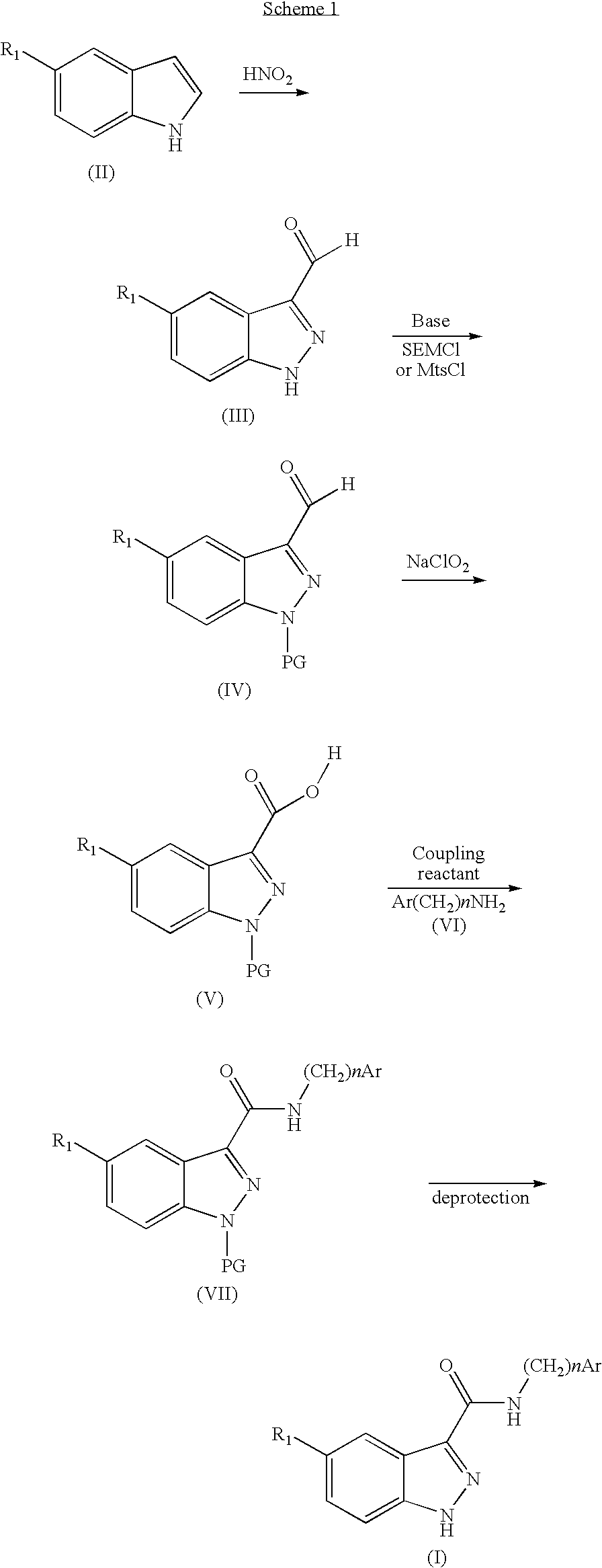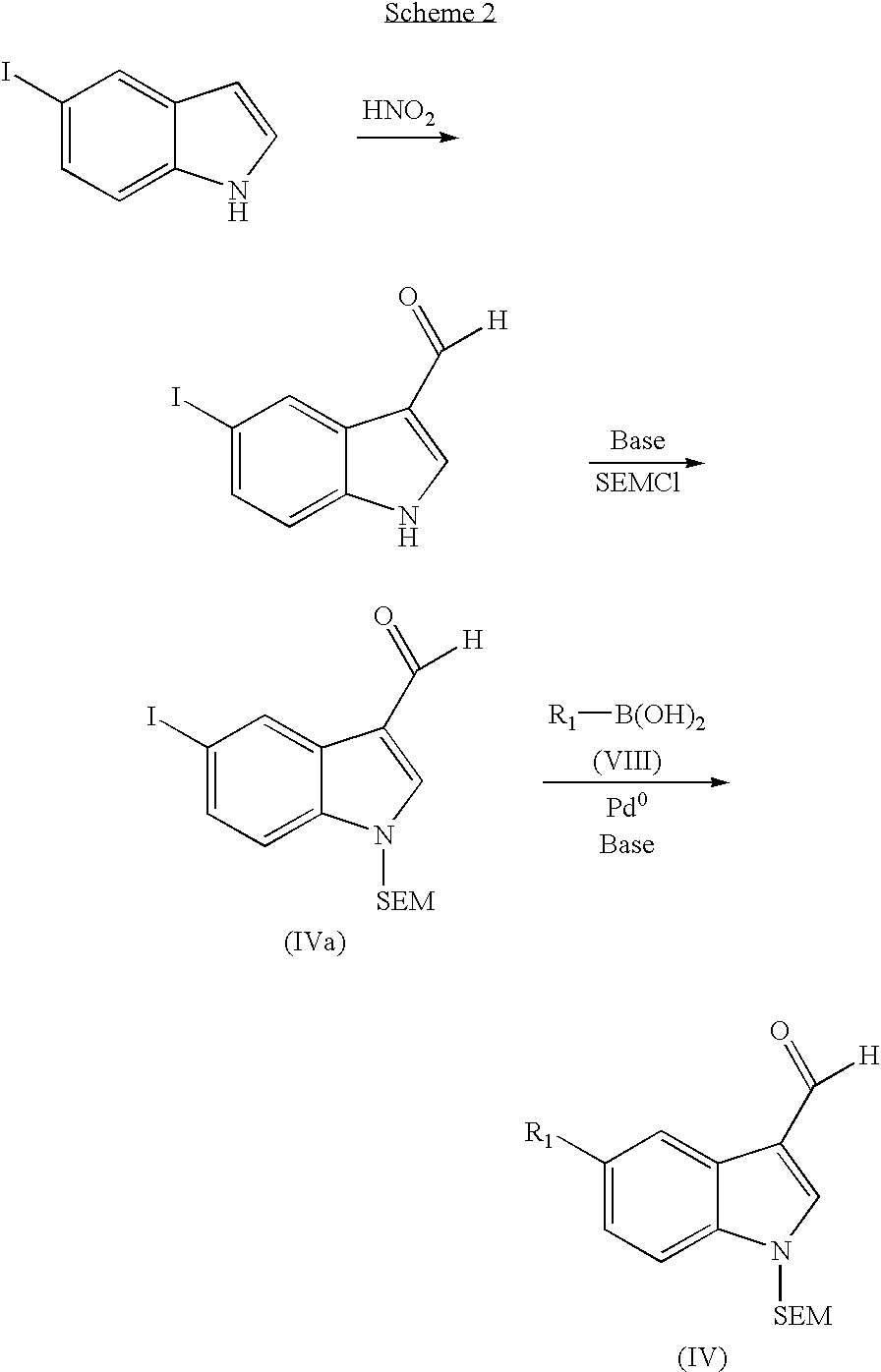Indazolecarboxamide derivatives for the treatment and prevention of malaria
a technology of indazolecarboxamide and derivatives, applied in the direction of biocide, antiparasitic agents, drug compositions, etc., can solve the problems of major public health problems and achieve the effect of treating and preventing malaria
- Summary
- Abstract
- Description
- Claims
- Application Information
AI Technical Summary
Benefits of technology
Problems solved by technology
Method used
Image
Examples
example 1
Compound No. 1
N-(Pyridin-4-yl)-5-pyridin-3-yl-1H-indazole-3-carboxamide hydrochloride
[0139]Intermediate 1.1
[0140]5-Iodo-1H-indazole-3-carboxylic acid
[0141]5-Iodoisatin (5 g, 18.3 mmol) is heated in the presence of sodium hydroxide (0.77 g, 19.2 mmol in 12 ml of H2O) until it is dissolved, and the reaction mixture is then cooled to 0° C. A solution of sodium nitrite precooled to 0° C. (1.26 g, 18.3 mmol in 5.5 ml of H2O) is added. The paste obtained is added portionwise, with vigorous stirring, to a solution of sulphuric acid (3.40 g, 34.8 mmol in 37 ml of H2O) precooled to 0° C. such that the temperature does not exceed 4° C. The stirring is maintained for 15 min and then a tin chloride solution (SnCl2.2H2O, 9.91 g, 43.9 mmol in 15 ml of concentrated HCl) is added slowly such that the temperature does not exceed 4° C. The mixture is left to react for several hours. The reaction mixture is filtered. The solid is washed with boiling water and then taken up with ethanol under hot condi...
example 2
Compound No. 2
N-(Pyridin-4-yl)-5-(4-methyl-[3,4′]-bipyridinyl-5-yl)-1H-indazole-3-carboxamide hydrochloride
[0156]Intermediate 2.1
[0157]3,5-Dibromo-4-methylpyridine
[0158]A solution of n-butyllithium in hexane (1.6 N, 16 ml) is added dropwise, under argon, to a solution of diisopropylamine (3.6 ml, 1.02 equiv.) in anhydrous THF (145 ml) maintained at −10° C. The reaction mixture is cooled to −78° C. and then a solution of 3,5-dibromopyridine (5.92 g, 25 mmol) in THF (200 ml), cooled to −78° C., is added dropwise. The reaction mixture is stirred for 30 min and then methyl iodide (2.17 ml, 1.4 equiv.) is added dropwise. The stirring is maintained for 2 h at −78° C. A saturated aqueous NH4Cl solution (120 ml) is added. After evaporation of the solvents, the reaction mixture is extracted with EtOAc. The organic phase is washed with brine, dried over MgSO4 and evaporated. The yellow solid obtained is taken up with EtOAc. The suspension is filtered. The filtrate is evaporated and the residu...
example 3
Compound No. 3
N-(Pyridin-4-yl)-5-isoquinolin-4-yl-1H-indazole-3-carboxamide
[0174]Intermediate 3.1
[0175]5-Iodo-1H-indazole-3-carbaldehyde
[0176]1 g of sodium nitrite (27.6 g, 400 mmol) is added portionwise, under argon, to a suspension of 5-iodoindole (9.722 g, 40 mmol) in water, followed dropwise by a 6N HCl solution (59 ml). The temperature of the reaction mixture is maintained below 15° C. and the reaction mixture is then left at ambient temperature overnight, with vigorous stirring. The nitrous vapours are expelled under a stream of argon, and the reaction mixture is then filtered. Washing the solid with H2O followed by purification on silica gel (600 g), elution being carried out according to an elution gradient from CH2Cl2 to a CH2Cl2 / EtOAc (9 / 1) mixture, makes it possible to isolate 1.37 g of product in the form of a brown solid.
[0177]LC / MS / UV: MH+273 (88.6%)
[0178]Intermediate 3.2
[0179]5-Iodo-1-(2-trimethylsilylethoxymethyl)-1H-indazole-3-carbaldehyde
[0180]Intermediate 3.1 (2.5...
PUM
| Property | Measurement | Unit |
|---|---|---|
| temperature | aaaaa | aaaaa |
| temperature | aaaaa | aaaaa |
| temperature | aaaaa | aaaaa |
Abstract
Description
Claims
Application Information
 Login to View More
Login to View More - R&D
- Intellectual Property
- Life Sciences
- Materials
- Tech Scout
- Unparalleled Data Quality
- Higher Quality Content
- 60% Fewer Hallucinations
Browse by: Latest US Patents, China's latest patents, Technical Efficacy Thesaurus, Application Domain, Technology Topic, Popular Technical Reports.
© 2025 PatSnap. All rights reserved.Legal|Privacy policy|Modern Slavery Act Transparency Statement|Sitemap|About US| Contact US: help@patsnap.com



